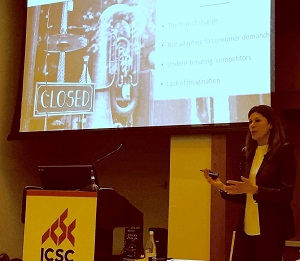Shopping centres, stores and brands which want to create better connections with customers should incorporate experiential retail strategies, including pop-up events.
This was the message from pop-up go founder and chief connector Linda Farha during a presentation during the recent International Council of Shopping Centers’ Canadian convention. Farha, whose firm provides an online meeting place bringing together organizations which want to host or execute pop-ups with appropriate spaces, was speaking at the Metro Toronto Convention Centre.
E-commerce has captured about 10 per cent of the Canadian retail market due to its convenience, ease of purchase, competitive pricing, wider range of products and access to international goods. Its drawbacks, however, include shipping costs, waiting for deliveries, privacy concerns, not being able to try products and a difficult return process.
These factors, along with the social aspects of going out to shop, have made the much-discussed brick-and-mortar “retail apocalypse” more myth than reality.
“Brands want to go where people are, and the people are still in stores,” said Farha, who’s also president of Zenergy Communications. “It’s just a matter of giving them what they want in terms of the shopping experience.”
The retail pop-up industry is worth an estimated $50 billion worldwide. Temporary retail installations initially gained traction in Europe before moving to North America, and Canada is now catching up to the United States.
The benefits of pop-ups
Farha said pop-ups can be used by brands to test a new market, launch a new product, reward loyal customers, increase brand awareness, connect with potential customers and gather intelligence for business-making decisions.
Pop-ups should be data-driven to help brands and retailers track, measure and understand consumers, while landlords can also gather statistical information to devise strategies regarding the types of tenants they’d like to attract.
“There’s no reason to do it if you’re not going to learn,” said Farha. “We’re creating an environment that will ask people to step out of their usual business constraints and be more open to bolder ideas.
“Retailers who go beyond and push the limits are the ones that are getting a lot of traction. It has to be constantly reinvented.”
What to consider in launching a pop-up
Some of the keys to creating a successful pop-up, according to Farha, are:
* they shouldn’t look temporary and should offer the same experience as something more permanent;
* starting with a clean slate, having high-quality images and using expert partners;
* proper staffing with people who can offer strategic counselling to customers;
* marketing and communication;
* having point-of-sale materials, insurance and payment processing.
Pop-up events typically last from three days to three months, and Farha said 10 days is generally a good time frame. Some landlords, however, don’t want pop-ups which would stay less than a month.
Landlords can benefit from pop-ups because they can create a buzz, drive foot traffic, attract other pop-ups and boost long-term tenants. Some shopping centres now have reserved spaces for them, and successful pop-ups can sometimes become permanent stores.
Farha said more mall managers should also consider taking better advantage of their outdoor space to create experiential pop-ups.
Some of the best pop-ups aren’t even focused on creating instant revenue, as products are sometimes given away to attract interest rather than being sold. A charitable element can also be introduced to pop-ups to appeal to people’s values.
Many pop-ups put an emphasis on social media and encourage visitors to post about or take photos of their experience. Experience per square foot is a new measurement used by some retailers to accompany sales per square foot to determine the impact and success of their location.
“Customer experience will overtake price and product as the key brand differentiator by the year 2020,” said Farha, who noted that 98 per cent of customers feel more inclined to make a purchase after being in an experiential environment.








